Contemporary Perspectives of Learning and Development: Bullying Report
VerifiedAdded on 2021/02/20
|12
|3438
|132
Report
AI Summary
This report provides a comprehensive analysis of bullying, focusing on its impact on children's learning and development. It begins with an executive summary, followed by an introduction defining bullying, its various forms (physical, verbal, social, and cyberbullying), and the factors that contribute to it. The report explores family and school factors, peer influence, and risk factors associated with children who are likely to become bullies. It then delves into the effects of bullying on children's learning and development, particularly in primary school settings. The report concludes with recommendations for inclusive bullying policies, addressing the roles of bullies, bystanders, and victims, and discusses teaching practices to mitigate bullying. References to relevant research are included throughout the report to support the findings.
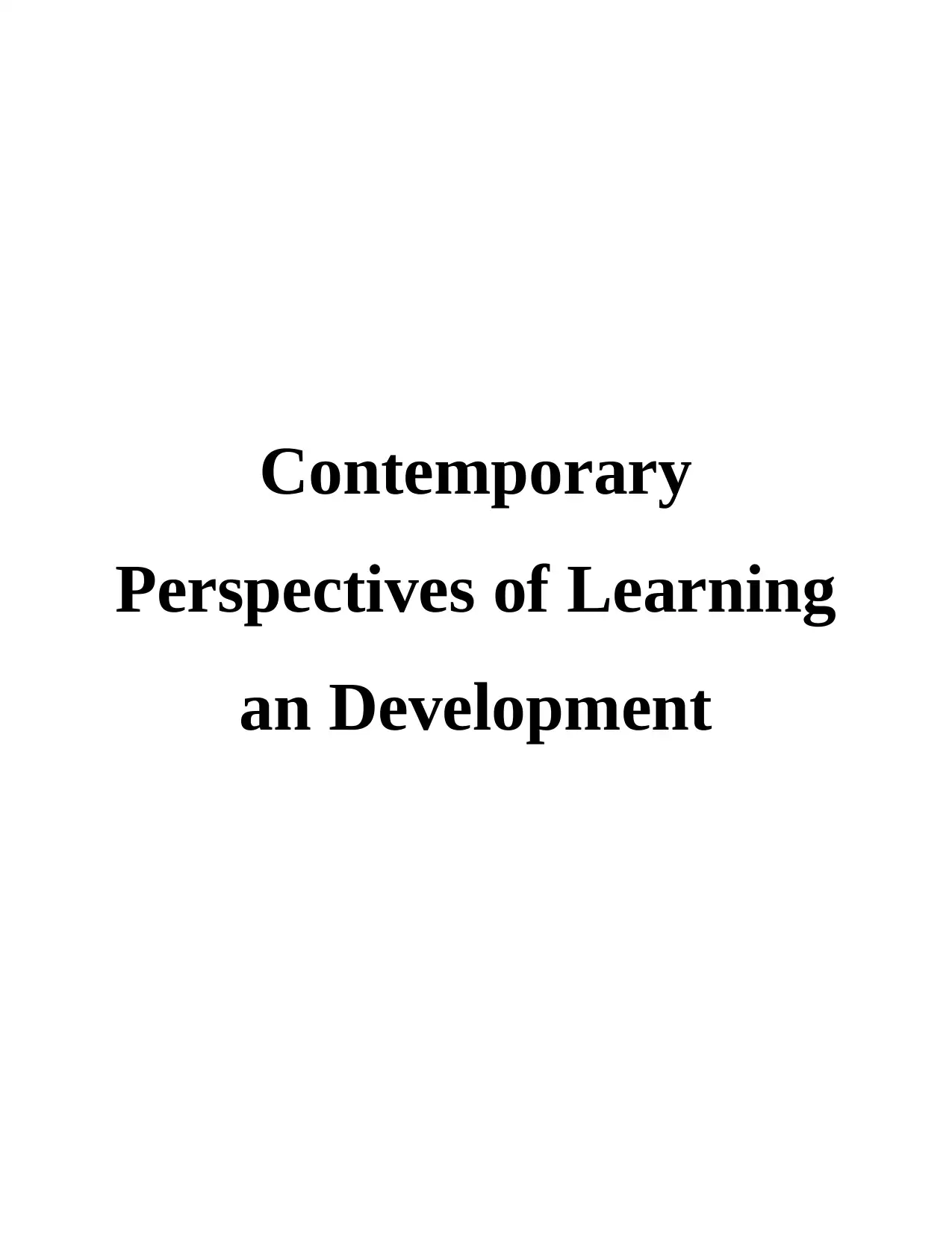
Contemporary
Perspectives of Learning
an Development
Perspectives of Learning
an Development
Paraphrase This Document
Need a fresh take? Get an instant paraphrase of this document with our AI Paraphraser
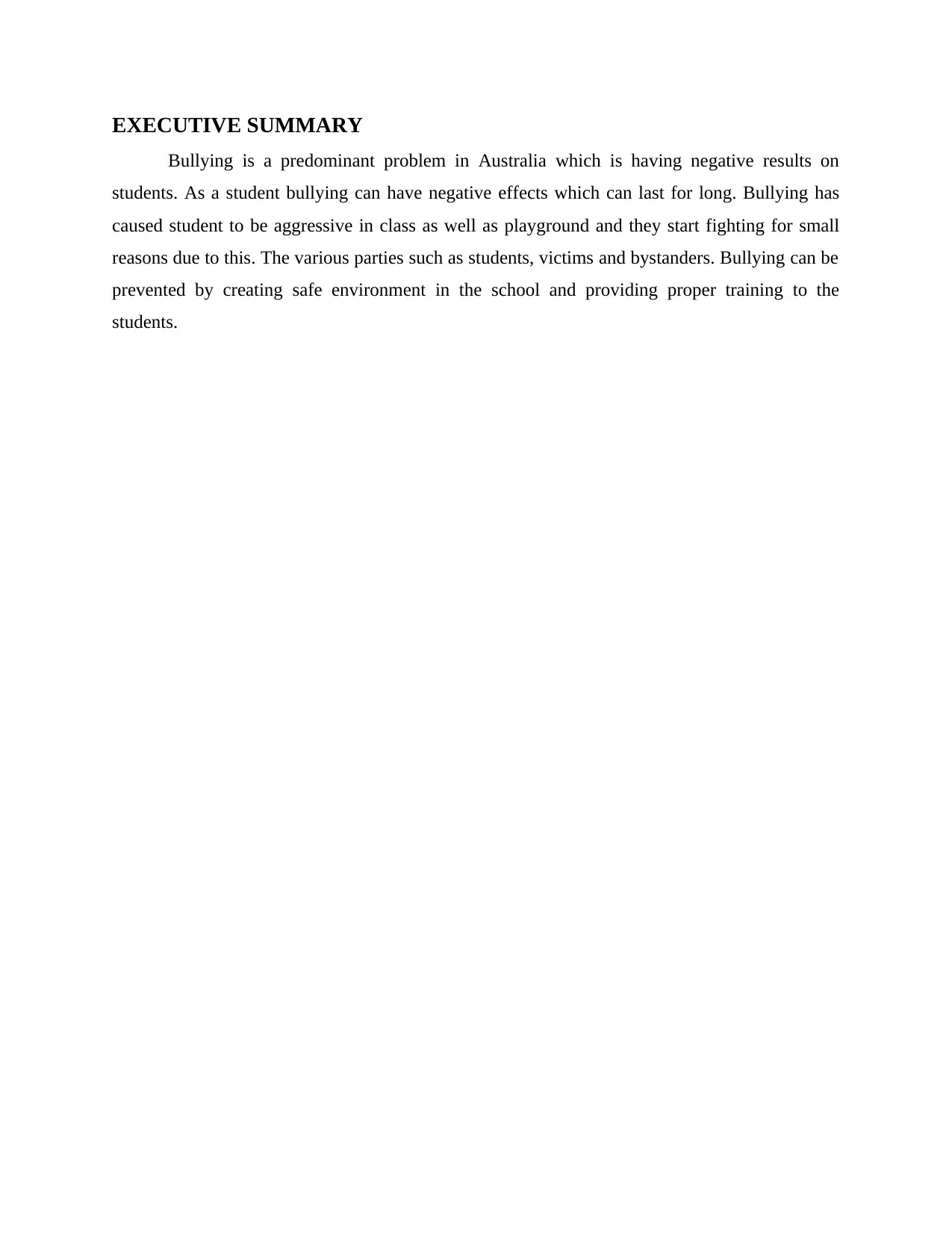
EXECUTIVE SUMMARY
Bullying is a predominant problem in Australia which is having negative results on
students. As a student bullying can have negative effects which can last for long. Bullying has
caused student to be aggressive in class as well as playground and they start fighting for small
reasons due to this. The various parties such as students, victims and bystanders. Bullying can be
prevented by creating safe environment in the school and providing proper training to the
students.
Bullying is a predominant problem in Australia which is having negative results on
students. As a student bullying can have negative effects which can last for long. Bullying has
caused student to be aggressive in class as well as playground and they start fighting for small
reasons due to this. The various parties such as students, victims and bystanders. Bullying can be
prevented by creating safe environment in the school and providing proper training to the
students.
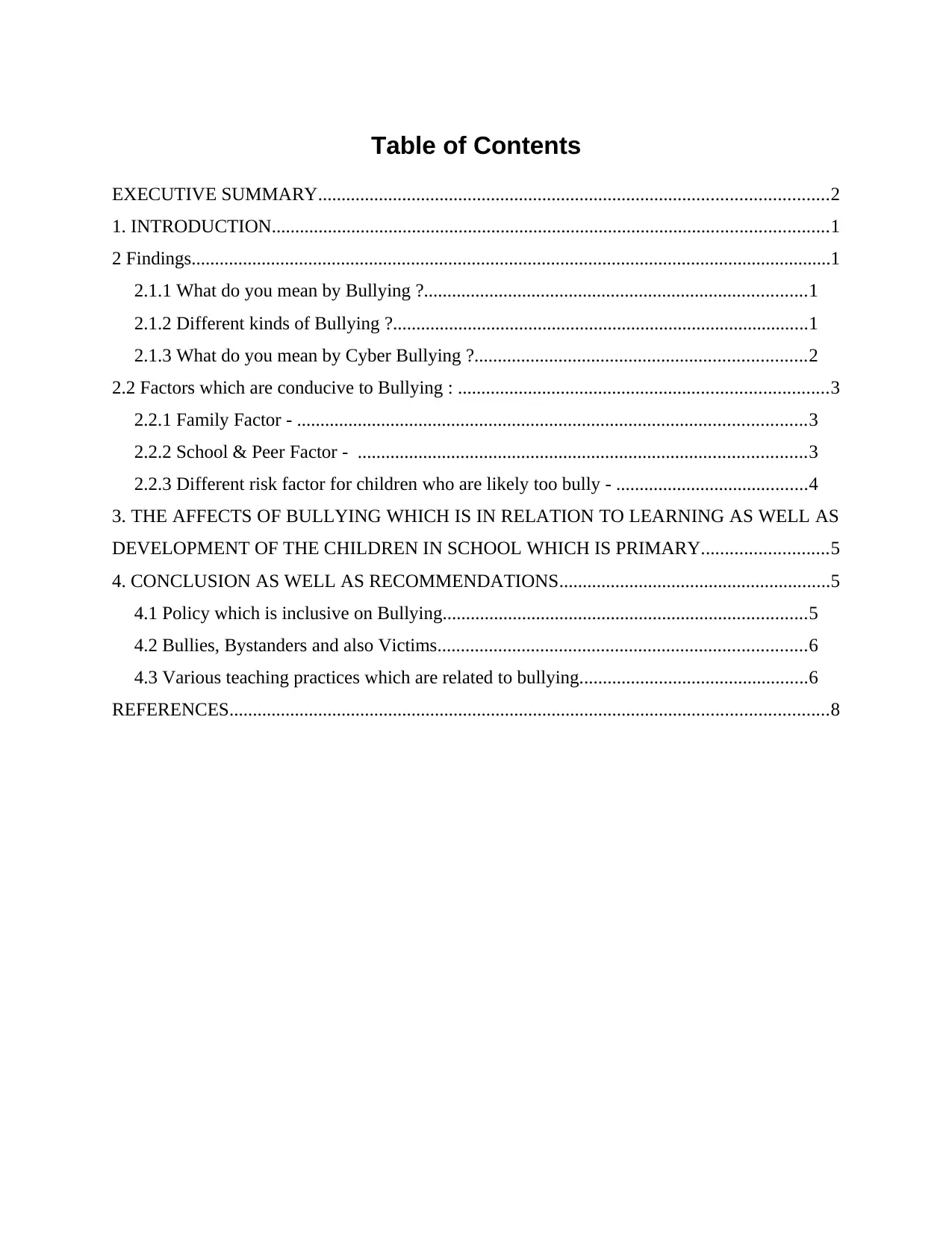
Table of Contents
EXECUTIVE SUMMARY.............................................................................................................2
1. INTRODUCTION.......................................................................................................................1
2 Findings.........................................................................................................................................1
2.1.1 What do you mean by Bullying ?..................................................................................1
2.1.2 Different kinds of Bullying ?.........................................................................................1
2.1.3 What do you mean by Cyber Bullying ?.......................................................................2
2.2 Factors which are conducive to Bullying : ...............................................................................3
2.2.1 Family Factor - .............................................................................................................3
2.2.2 School & Peer Factor - ................................................................................................3
2.2.3 Different risk factor for children who are likely too bully - .........................................4
3. THE AFFECTS OF BULLYING WHICH IS IN RELATION TO LEARNING AS WELL AS
DEVELOPMENT OF THE CHILDREN IN SCHOOL WHICH IS PRIMARY...........................5
4. CONCLUSION AS WELL AS RECOMMENDATIONS..........................................................5
4.1 Policy which is inclusive on Bullying..............................................................................5
4.2 Bullies, Bystanders and also Victims...............................................................................6
4.3 Various teaching practices which are related to bullying.................................................6
REFERENCES................................................................................................................................8
EXECUTIVE SUMMARY.............................................................................................................2
1. INTRODUCTION.......................................................................................................................1
2 Findings.........................................................................................................................................1
2.1.1 What do you mean by Bullying ?..................................................................................1
2.1.2 Different kinds of Bullying ?.........................................................................................1
2.1.3 What do you mean by Cyber Bullying ?.......................................................................2
2.2 Factors which are conducive to Bullying : ...............................................................................3
2.2.1 Family Factor - .............................................................................................................3
2.2.2 School & Peer Factor - ................................................................................................3
2.2.3 Different risk factor for children who are likely too bully - .........................................4
3. THE AFFECTS OF BULLYING WHICH IS IN RELATION TO LEARNING AS WELL AS
DEVELOPMENT OF THE CHILDREN IN SCHOOL WHICH IS PRIMARY...........................5
4. CONCLUSION AS WELL AS RECOMMENDATIONS..........................................................5
4.1 Policy which is inclusive on Bullying..............................................................................5
4.2 Bullies, Bystanders and also Victims...............................................................................6
4.3 Various teaching practices which are related to bullying.................................................6
REFERENCES................................................................................................................................8
⊘ This is a preview!⊘
Do you want full access?
Subscribe today to unlock all pages.

Trusted by 1+ million students worldwide
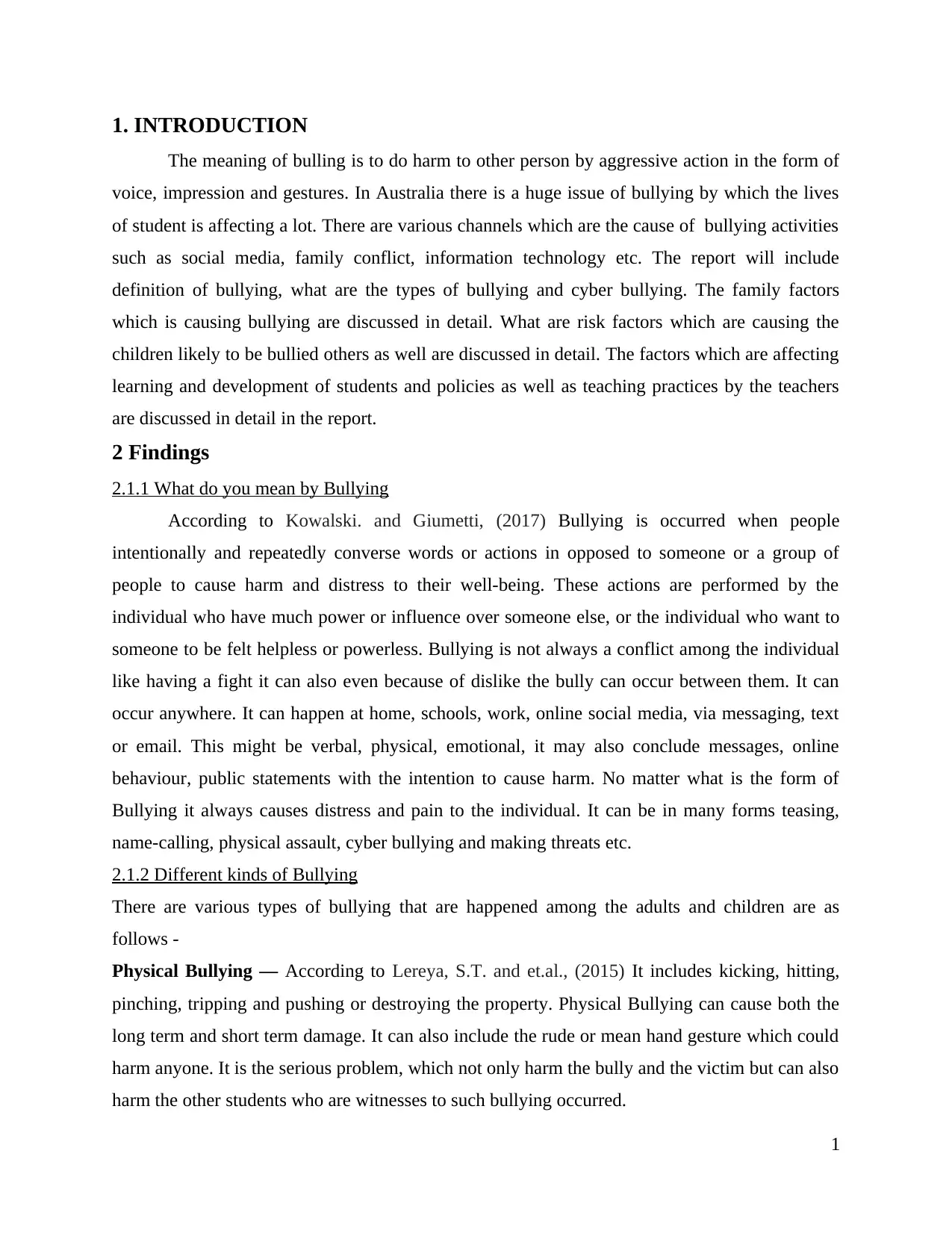
1. INTRODUCTION
The meaning of bulling is to do harm to other person by aggressive action in the form of
voice, impression and gestures. In Australia there is a huge issue of bullying by which the lives
of student is affecting a lot. There are various channels which are the cause of bullying activities
such as social media, family conflict, information technology etc. The report will include
definition of bullying, what are the types of bullying and cyber bullying. The family factors
which is causing bullying are discussed in detail. What are risk factors which are causing the
children likely to be bullied others as well are discussed in detail. The factors which are affecting
learning and development of students and policies as well as teaching practices by the teachers
are discussed in detail in the report.
2 Findings
2.1.1 What do you mean by Bullying
According to Kowalski. and Giumetti, (2017) Bullying is occurred when people
intentionally and repeatedly converse words or actions in opposed to someone or a group of
people to cause harm and distress to their well-being. These actions are performed by the
individual who have much power or influence over someone else, or the individual who want to
someone to be felt helpless or powerless. Bullying is not always a conflict among the individual
like having a fight it can also even because of dislike the bully can occur between them. It can
occur anywhere. It can happen at home, schools, work, online social media, via messaging, text
or email. This might be verbal, physical, emotional, it may also conclude messages, online
behaviour, public statements with the intention to cause harm. No matter what is the form of
Bullying it always causes distress and pain to the individual. It can be in many forms teasing,
name-calling, physical assault, cyber bullying and making threats etc.
2.1.2 Different kinds of Bullying
There are various types of bullying that are happened among the adults and children are as
follows -
Physical Bullying — According to Lereya, S.T. and et.al., (2015) It includes kicking, hitting,
pinching, tripping and pushing or destroying the property. Physical Bullying can cause both the
long term and short term damage. It can also include the rude or mean hand gesture which could
harm anyone. It is the serious problem, which not only harm the bully and the victim but can also
harm the other students who are witnesses to such bullying occurred.
1
The meaning of bulling is to do harm to other person by aggressive action in the form of
voice, impression and gestures. In Australia there is a huge issue of bullying by which the lives
of student is affecting a lot. There are various channels which are the cause of bullying activities
such as social media, family conflict, information technology etc. The report will include
definition of bullying, what are the types of bullying and cyber bullying. The family factors
which is causing bullying are discussed in detail. What are risk factors which are causing the
children likely to be bullied others as well are discussed in detail. The factors which are affecting
learning and development of students and policies as well as teaching practices by the teachers
are discussed in detail in the report.
2 Findings
2.1.1 What do you mean by Bullying
According to Kowalski. and Giumetti, (2017) Bullying is occurred when people
intentionally and repeatedly converse words or actions in opposed to someone or a group of
people to cause harm and distress to their well-being. These actions are performed by the
individual who have much power or influence over someone else, or the individual who want to
someone to be felt helpless or powerless. Bullying is not always a conflict among the individual
like having a fight it can also even because of dislike the bully can occur between them. It can
occur anywhere. It can happen at home, schools, work, online social media, via messaging, text
or email. This might be verbal, physical, emotional, it may also conclude messages, online
behaviour, public statements with the intention to cause harm. No matter what is the form of
Bullying it always causes distress and pain to the individual. It can be in many forms teasing,
name-calling, physical assault, cyber bullying and making threats etc.
2.1.2 Different kinds of Bullying
There are various types of bullying that are happened among the adults and children are as
follows -
Physical Bullying — According to Lereya, S.T. and et.al., (2015) It includes kicking, hitting,
pinching, tripping and pushing or destroying the property. Physical Bullying can cause both the
long term and short term damage. It can also include the rude or mean hand gesture which could
harm anyone. It is the serious problem, which not only harm the bully and the victim but can also
harm the other students who are witnesses to such bullying occurred.
1
Paraphrase This Document
Need a fresh take? Get an instant paraphrase of this document with our AI Paraphraser
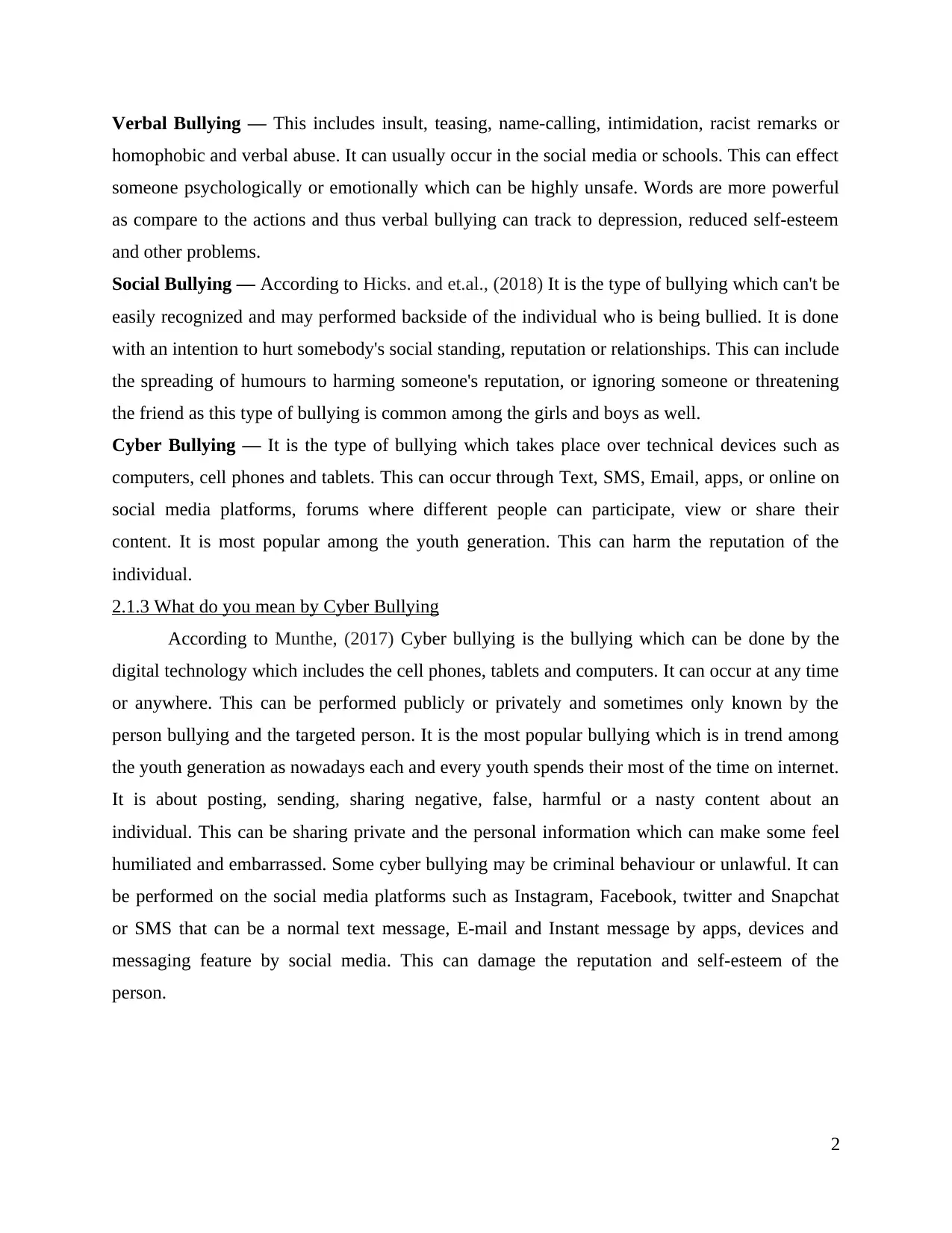
Verbal Bullying — This includes insult, teasing, name-calling, intimidation, racist remarks or
homophobic and verbal abuse. It can usually occur in the social media or schools. This can effect
someone psychologically or emotionally which can be highly unsafe. Words are more powerful
as compare to the actions and thus verbal bullying can track to depression, reduced self-esteem
and other problems.
Social Bullying — According to Hicks. and et.al., (2018) It is the type of bullying which can't be
easily recognized and may performed backside of the individual who is being bullied. It is done
with an intention to hurt somebody's social standing, reputation or relationships. This can include
the spreading of humours to harming someone's reputation, or ignoring someone or threatening
the friend as this type of bullying is common among the girls and boys as well.
Cyber Bullying — It is the type of bullying which takes place over technical devices such as
computers, cell phones and tablets. This can occur through Text, SMS, Email, apps, or online on
social media platforms, forums where different people can participate, view or share their
content. It is most popular among the youth generation. This can harm the reputation of the
individual.
2.1.3 What do you mean by Cyber Bullying
According to Munthe, (2017) Cyber bullying is the bullying which can be done by the
digital technology which includes the cell phones, tablets and computers. It can occur at any time
or anywhere. This can be performed publicly or privately and sometimes only known by the
person bullying and the targeted person. It is the most popular bullying which is in trend among
the youth generation as nowadays each and every youth spends their most of the time on internet.
It is about posting, sending, sharing negative, false, harmful or a nasty content about an
individual. This can be sharing private and the personal information which can make some feel
humiliated and embarrassed. Some cyber bullying may be criminal behaviour or unlawful. It can
be performed on the social media platforms such as Instagram, Facebook, twitter and Snapchat
or SMS that can be a normal text message, E-mail and Instant message by apps, devices and
messaging feature by social media. This can damage the reputation and self-esteem of the
person.
2
homophobic and verbal abuse. It can usually occur in the social media or schools. This can effect
someone psychologically or emotionally which can be highly unsafe. Words are more powerful
as compare to the actions and thus verbal bullying can track to depression, reduced self-esteem
and other problems.
Social Bullying — According to Hicks. and et.al., (2018) It is the type of bullying which can't be
easily recognized and may performed backside of the individual who is being bullied. It is done
with an intention to hurt somebody's social standing, reputation or relationships. This can include
the spreading of humours to harming someone's reputation, or ignoring someone or threatening
the friend as this type of bullying is common among the girls and boys as well.
Cyber Bullying — It is the type of bullying which takes place over technical devices such as
computers, cell phones and tablets. This can occur through Text, SMS, Email, apps, or online on
social media platforms, forums where different people can participate, view or share their
content. It is most popular among the youth generation. This can harm the reputation of the
individual.
2.1.3 What do you mean by Cyber Bullying
According to Munthe, (2017) Cyber bullying is the bullying which can be done by the
digital technology which includes the cell phones, tablets and computers. It can occur at any time
or anywhere. This can be performed publicly or privately and sometimes only known by the
person bullying and the targeted person. It is the most popular bullying which is in trend among
the youth generation as nowadays each and every youth spends their most of the time on internet.
It is about posting, sending, sharing negative, false, harmful or a nasty content about an
individual. This can be sharing private and the personal information which can make some feel
humiliated and embarrassed. Some cyber bullying may be criminal behaviour or unlawful. It can
be performed on the social media platforms such as Instagram, Facebook, twitter and Snapchat
or SMS that can be a normal text message, E-mail and Instant message by apps, devices and
messaging feature by social media. This can damage the reputation and self-esteem of the
person.
2
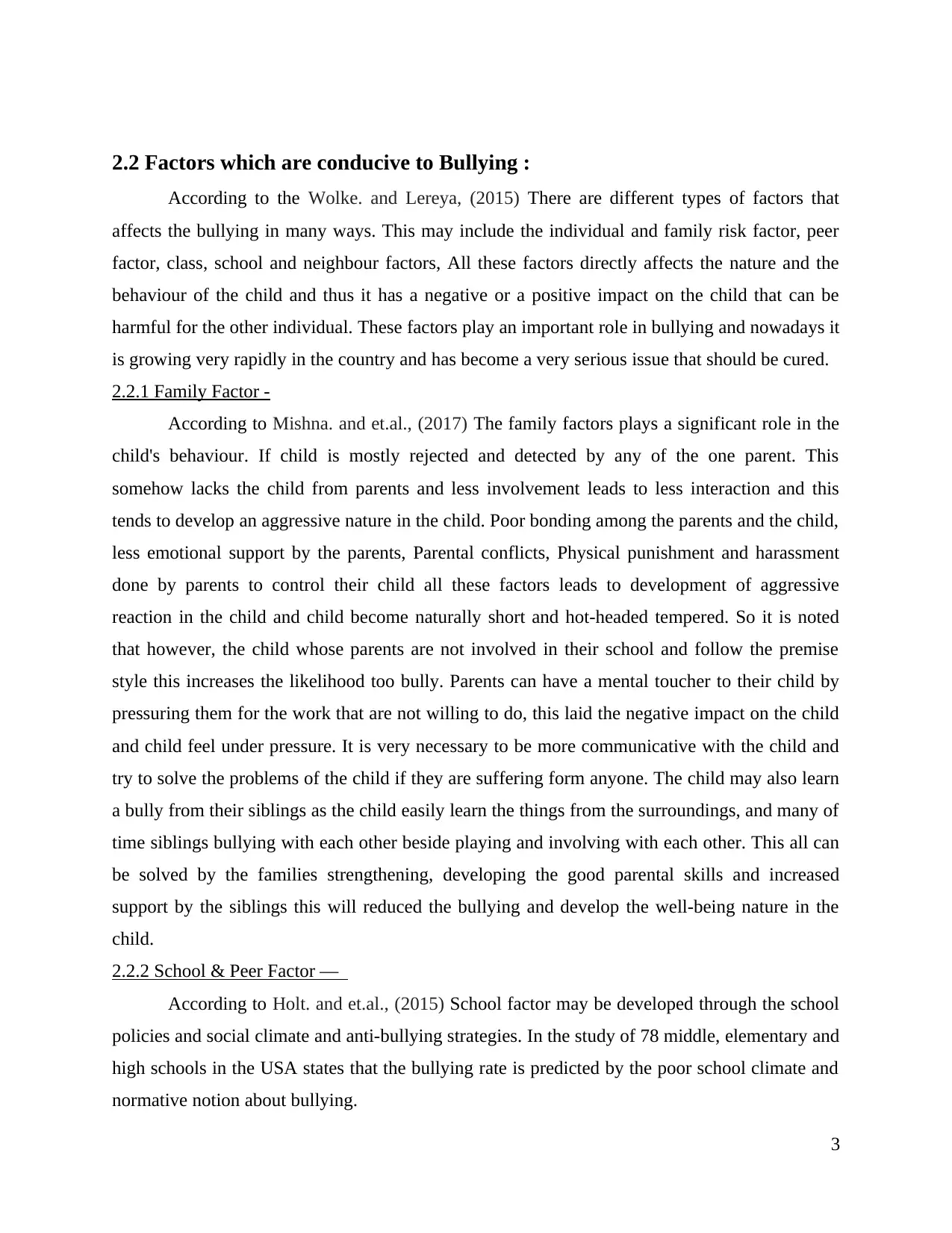
2.2 Factors which are conducive to Bullying :
According to the Wolke. and Lereya, (2015) There are different types of factors that
affects the bullying in many ways. This may include the individual and family risk factor, peer
factor, class, school and neighbour factors, All these factors directly affects the nature and the
behaviour of the child and thus it has a negative or a positive impact on the child that can be
harmful for the other individual. These factors play an important role in bullying and nowadays it
is growing very rapidly in the country and has become a very serious issue that should be cured.
2.2.1 Family Factor -
According to Mishna. and et.al., (2017) The family factors plays a significant role in the
child's behaviour. If child is mostly rejected and detected by any of the one parent. This
somehow lacks the child from parents and less involvement leads to less interaction and this
tends to develop an aggressive nature in the child. Poor bonding among the parents and the child,
less emotional support by the parents, Parental conflicts, Physical punishment and harassment
done by parents to control their child all these factors leads to development of aggressive
reaction in the child and child become naturally short and hot-headed tempered. So it is noted
that however, the child whose parents are not involved in their school and follow the premise
style this increases the likelihood too bully. Parents can have a mental toucher to their child by
pressuring them for the work that are not willing to do, this laid the negative impact on the child
and child feel under pressure. It is very necessary to be more communicative with the child and
try to solve the problems of the child if they are suffering form anyone. The child may also learn
a bully from their siblings as the child easily learn the things from the surroundings, and many of
time siblings bullying with each other beside playing and involving with each other. This all can
be solved by the families strengthening, developing the good parental skills and increased
support by the siblings this will reduced the bullying and develop the well-being nature in the
child.
2.2.2 School & Peer Factor —
According to Holt. and et.al., (2015) School factor may be developed through the school
policies and social climate and anti-bullying strategies. In the study of 78 middle, elementary and
high schools in the USA states that the bullying rate is predicted by the poor school climate and
normative notion about bullying.
3
According to the Wolke. and Lereya, (2015) There are different types of factors that
affects the bullying in many ways. This may include the individual and family risk factor, peer
factor, class, school and neighbour factors, All these factors directly affects the nature and the
behaviour of the child and thus it has a negative or a positive impact on the child that can be
harmful for the other individual. These factors play an important role in bullying and nowadays it
is growing very rapidly in the country and has become a very serious issue that should be cured.
2.2.1 Family Factor -
According to Mishna. and et.al., (2017) The family factors plays a significant role in the
child's behaviour. If child is mostly rejected and detected by any of the one parent. This
somehow lacks the child from parents and less involvement leads to less interaction and this
tends to develop an aggressive nature in the child. Poor bonding among the parents and the child,
less emotional support by the parents, Parental conflicts, Physical punishment and harassment
done by parents to control their child all these factors leads to development of aggressive
reaction in the child and child become naturally short and hot-headed tempered. So it is noted
that however, the child whose parents are not involved in their school and follow the premise
style this increases the likelihood too bully. Parents can have a mental toucher to their child by
pressuring them for the work that are not willing to do, this laid the negative impact on the child
and child feel under pressure. It is very necessary to be more communicative with the child and
try to solve the problems of the child if they are suffering form anyone. The child may also learn
a bully from their siblings as the child easily learn the things from the surroundings, and many of
time siblings bullying with each other beside playing and involving with each other. This all can
be solved by the families strengthening, developing the good parental skills and increased
support by the siblings this will reduced the bullying and develop the well-being nature in the
child.
2.2.2 School & Peer Factor —
According to Holt. and et.al., (2015) School factor may be developed through the school
policies and social climate and anti-bullying strategies. In the study of 78 middle, elementary and
high schools in the USA states that the bullying rate is predicted by the poor school climate and
normative notion about bullying.
3
⊘ This is a preview!⊘
Do you want full access?
Subscribe today to unlock all pages.

Trusted by 1+ million students worldwide
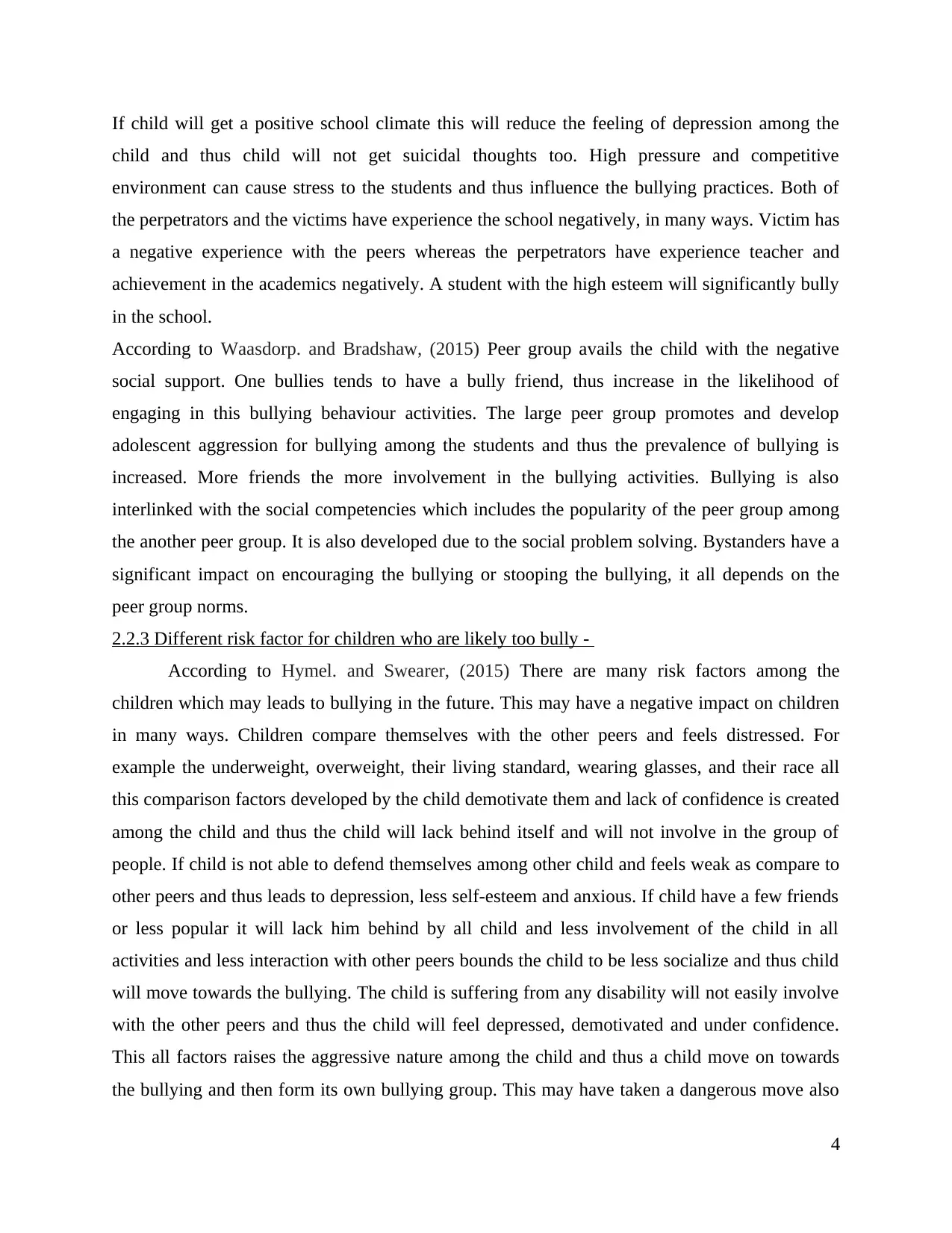
If child will get a positive school climate this will reduce the feeling of depression among the
child and thus child will not get suicidal thoughts too. High pressure and competitive
environment can cause stress to the students and thus influence the bullying practices. Both of
the perpetrators and the victims have experience the school negatively, in many ways. Victim has
a negative experience with the peers whereas the perpetrators have experience teacher and
achievement in the academics negatively. A student with the high esteem will significantly bully
in the school.
According to Waasdorp. and Bradshaw, (2015) Peer group avails the child with the negative
social support. One bullies tends to have a bully friend, thus increase in the likelihood of
engaging in this bullying behaviour activities. The large peer group promotes and develop
adolescent aggression for bullying among the students and thus the prevalence of bullying is
increased. More friends the more involvement in the bullying activities. Bullying is also
interlinked with the social competencies which includes the popularity of the peer group among
the another peer group. It is also developed due to the social problem solving. Bystanders have a
significant impact on encouraging the bullying or stooping the bullying, it all depends on the
peer group norms.
2.2.3 Different risk factor for children who are likely too bully -
According to Hymel. and Swearer, (2015) There are many risk factors among the
children which may leads to bullying in the future. This may have a negative impact on children
in many ways. Children compare themselves with the other peers and feels distressed. For
example the underweight, overweight, their living standard, wearing glasses, and their race all
this comparison factors developed by the child demotivate them and lack of confidence is created
among the child and thus the child will lack behind itself and will not involve in the group of
people. If child is not able to defend themselves among other child and feels weak as compare to
other peers and thus leads to depression, less self-esteem and anxious. If child have a few friends
or less popular it will lack him behind by all child and less involvement of the child in all
activities and less interaction with other peers bounds the child to be less socialize and thus child
will move towards the bullying. The child is suffering from any disability will not easily involve
with the other peers and thus the child will feel depressed, demotivated and under confidence.
This all factors raises the aggressive nature among the child and thus a child move on towards
the bullying and then form its own bullying group. This may have taken a dangerous move also
4
child and thus child will not get suicidal thoughts too. High pressure and competitive
environment can cause stress to the students and thus influence the bullying practices. Both of
the perpetrators and the victims have experience the school negatively, in many ways. Victim has
a negative experience with the peers whereas the perpetrators have experience teacher and
achievement in the academics negatively. A student with the high esteem will significantly bully
in the school.
According to Waasdorp. and Bradshaw, (2015) Peer group avails the child with the negative
social support. One bullies tends to have a bully friend, thus increase in the likelihood of
engaging in this bullying behaviour activities. The large peer group promotes and develop
adolescent aggression for bullying among the students and thus the prevalence of bullying is
increased. More friends the more involvement in the bullying activities. Bullying is also
interlinked with the social competencies which includes the popularity of the peer group among
the another peer group. It is also developed due to the social problem solving. Bystanders have a
significant impact on encouraging the bullying or stooping the bullying, it all depends on the
peer group norms.
2.2.3 Different risk factor for children who are likely too bully -
According to Hymel. and Swearer, (2015) There are many risk factors among the
children which may leads to bullying in the future. This may have a negative impact on children
in many ways. Children compare themselves with the other peers and feels distressed. For
example the underweight, overweight, their living standard, wearing glasses, and their race all
this comparison factors developed by the child demotivate them and lack of confidence is created
among the child and thus the child will lack behind itself and will not involve in the group of
people. If child is not able to defend themselves among other child and feels weak as compare to
other peers and thus leads to depression, less self-esteem and anxious. If child have a few friends
or less popular it will lack him behind by all child and less involvement of the child in all
activities and less interaction with other peers bounds the child to be less socialize and thus child
will move towards the bullying. The child is suffering from any disability will not easily involve
with the other peers and thus the child will feel depressed, demotivated and under confidence.
This all factors raises the aggressive nature among the child and thus a child move on towards
the bullying and then form its own bullying group. This may have taken a dangerous move also
4
Paraphrase This Document
Need a fresh take? Get an instant paraphrase of this document with our AI Paraphraser
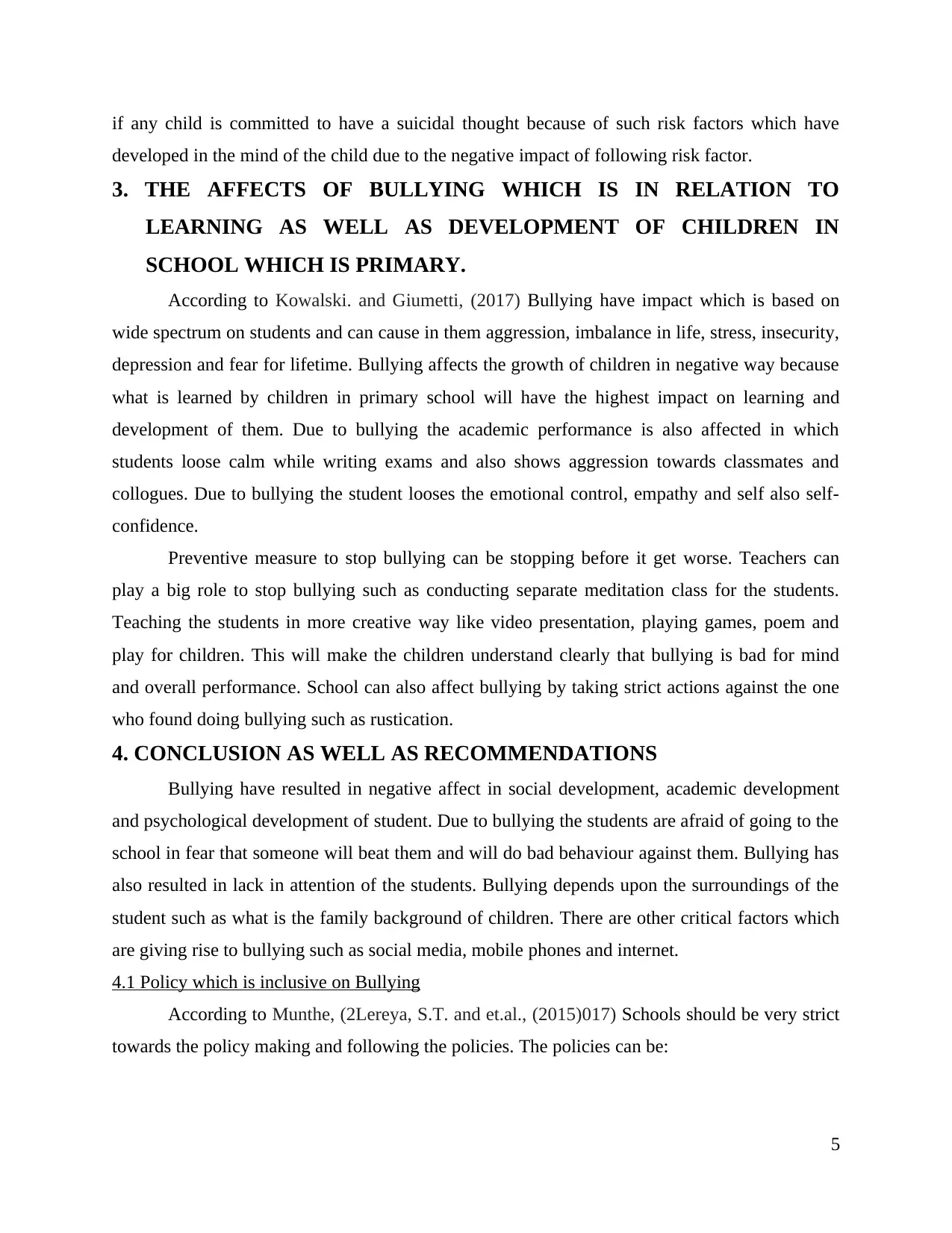
if any child is committed to have a suicidal thought because of such risk factors which have
developed in the mind of the child due to the negative impact of following risk factor.
3. THE AFFECTS OF BULLYING WHICH IS IN RELATION TO
LEARNING AS WELL AS DEVELOPMENT OF CHILDREN IN
SCHOOL WHICH IS PRIMARY.
According to Kowalski. and Giumetti, (2017) Bullying have impact which is based on
wide spectrum on students and can cause in them aggression, imbalance in life, stress, insecurity,
depression and fear for lifetime. Bullying affects the growth of children in negative way because
what is learned by children in primary school will have the highest impact on learning and
development of them. Due to bullying the academic performance is also affected in which
students loose calm while writing exams and also shows aggression towards classmates and
collogues. Due to bullying the student looses the emotional control, empathy and self also self-
confidence.
Preventive measure to stop bullying can be stopping before it get worse. Teachers can
play a big role to stop bullying such as conducting separate meditation class for the students.
Teaching the students in more creative way like video presentation, playing games, poem and
play for children. This will make the children understand clearly that bullying is bad for mind
and overall performance. School can also affect bullying by taking strict actions against the one
who found doing bullying such as rustication.
4. CONCLUSION AS WELL AS RECOMMENDATIONS
Bullying have resulted in negative affect in social development, academic development
and psychological development of student. Due to bullying the students are afraid of going to the
school in fear that someone will beat them and will do bad behaviour against them. Bullying has
also resulted in lack in attention of the students. Bullying depends upon the surroundings of the
student such as what is the family background of children. There are other critical factors which
are giving rise to bullying such as social media, mobile phones and internet.
4.1 Policy which is inclusive on Bullying
According to Munthe, (2Lereya, S.T. and et.al., (2015)017) Schools should be very strict
towards the policy making and following the policies. The policies can be:
5
developed in the mind of the child due to the negative impact of following risk factor.
3. THE AFFECTS OF BULLYING WHICH IS IN RELATION TO
LEARNING AS WELL AS DEVELOPMENT OF CHILDREN IN
SCHOOL WHICH IS PRIMARY.
According to Kowalski. and Giumetti, (2017) Bullying have impact which is based on
wide spectrum on students and can cause in them aggression, imbalance in life, stress, insecurity,
depression and fear for lifetime. Bullying affects the growth of children in negative way because
what is learned by children in primary school will have the highest impact on learning and
development of them. Due to bullying the academic performance is also affected in which
students loose calm while writing exams and also shows aggression towards classmates and
collogues. Due to bullying the student looses the emotional control, empathy and self also self-
confidence.
Preventive measure to stop bullying can be stopping before it get worse. Teachers can
play a big role to stop bullying such as conducting separate meditation class for the students.
Teaching the students in more creative way like video presentation, playing games, poem and
play for children. This will make the children understand clearly that bullying is bad for mind
and overall performance. School can also affect bullying by taking strict actions against the one
who found doing bullying such as rustication.
4. CONCLUSION AS WELL AS RECOMMENDATIONS
Bullying have resulted in negative affect in social development, academic development
and psychological development of student. Due to bullying the students are afraid of going to the
school in fear that someone will beat them and will do bad behaviour against them. Bullying has
also resulted in lack in attention of the students. Bullying depends upon the surroundings of the
student such as what is the family background of children. There are other critical factors which
are giving rise to bullying such as social media, mobile phones and internet.
4.1 Policy which is inclusive on Bullying
According to Munthe, (2Lereya, S.T. and et.al., (2015)017) Schools should be very strict
towards the policy making and following the policies. The policies can be:
5
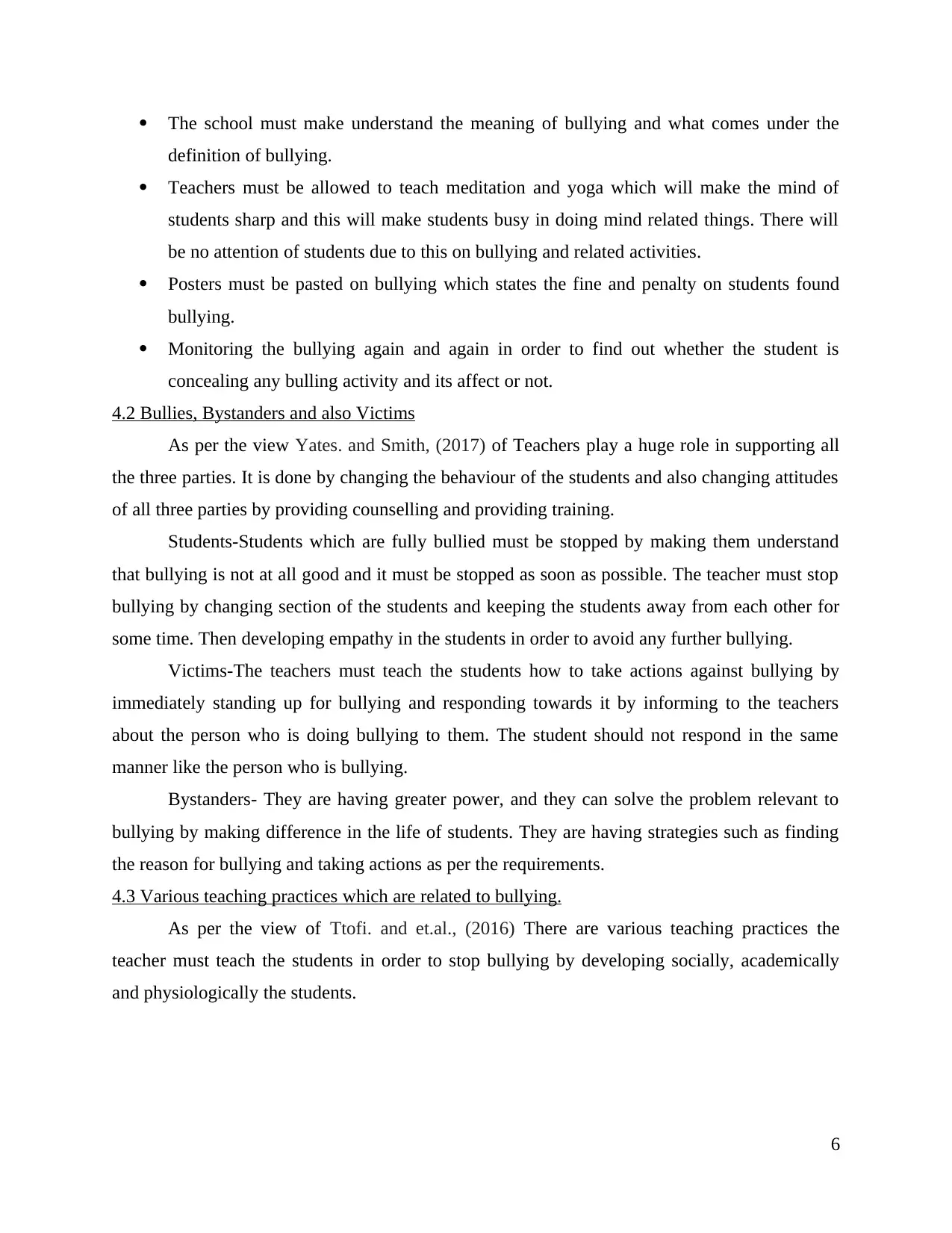
The school must make understand the meaning of bullying and what comes under the
definition of bullying.
Teachers must be allowed to teach meditation and yoga which will make the mind of
students sharp and this will make students busy in doing mind related things. There will
be no attention of students due to this on bullying and related activities.
Posters must be pasted on bullying which states the fine and penalty on students found
bullying.
Monitoring the bullying again and again in order to find out whether the student is
concealing any bulling activity and its affect or not.
4.2 Bullies, Bystanders and also Victims
As per the view Yates. and Smith, (2017) of Teachers play a huge role in supporting all
the three parties. It is done by changing the behaviour of the students and also changing attitudes
of all three parties by providing counselling and providing training.
Students-Students which are fully bullied must be stopped by making them understand
that bullying is not at all good and it must be stopped as soon as possible. The teacher must stop
bullying by changing section of the students and keeping the students away from each other for
some time. Then developing empathy in the students in order to avoid any further bullying.
Victims-The teachers must teach the students how to take actions against bullying by
immediately standing up for bullying and responding towards it by informing to the teachers
about the person who is doing bullying to them. The student should not respond in the same
manner like the person who is bullying.
Bystanders- They are having greater power, and they can solve the problem relevant to
bullying by making difference in the life of students. They are having strategies such as finding
the reason for bullying and taking actions as per the requirements.
4.3 Various teaching practices which are related to bullying.
As per the view of Ttofi. and et.al., (2016) There are various teaching practices the
teacher must teach the students in order to stop bullying by developing socially, academically
and physiologically the students.
6
definition of bullying.
Teachers must be allowed to teach meditation and yoga which will make the mind of
students sharp and this will make students busy in doing mind related things. There will
be no attention of students due to this on bullying and related activities.
Posters must be pasted on bullying which states the fine and penalty on students found
bullying.
Monitoring the bullying again and again in order to find out whether the student is
concealing any bulling activity and its affect or not.
4.2 Bullies, Bystanders and also Victims
As per the view Yates. and Smith, (2017) of Teachers play a huge role in supporting all
the three parties. It is done by changing the behaviour of the students and also changing attitudes
of all three parties by providing counselling and providing training.
Students-Students which are fully bullied must be stopped by making them understand
that bullying is not at all good and it must be stopped as soon as possible. The teacher must stop
bullying by changing section of the students and keeping the students away from each other for
some time. Then developing empathy in the students in order to avoid any further bullying.
Victims-The teachers must teach the students how to take actions against bullying by
immediately standing up for bullying and responding towards it by informing to the teachers
about the person who is doing bullying to them. The student should not respond in the same
manner like the person who is bullying.
Bystanders- They are having greater power, and they can solve the problem relevant to
bullying by making difference in the life of students. They are having strategies such as finding
the reason for bullying and taking actions as per the requirements.
4.3 Various teaching practices which are related to bullying.
As per the view of Ttofi. and et.al., (2016) There are various teaching practices the
teacher must teach the students in order to stop bullying by developing socially, academically
and physiologically the students.
6
⊘ This is a preview!⊘
Do you want full access?
Subscribe today to unlock all pages.

Trusted by 1+ million students worldwide
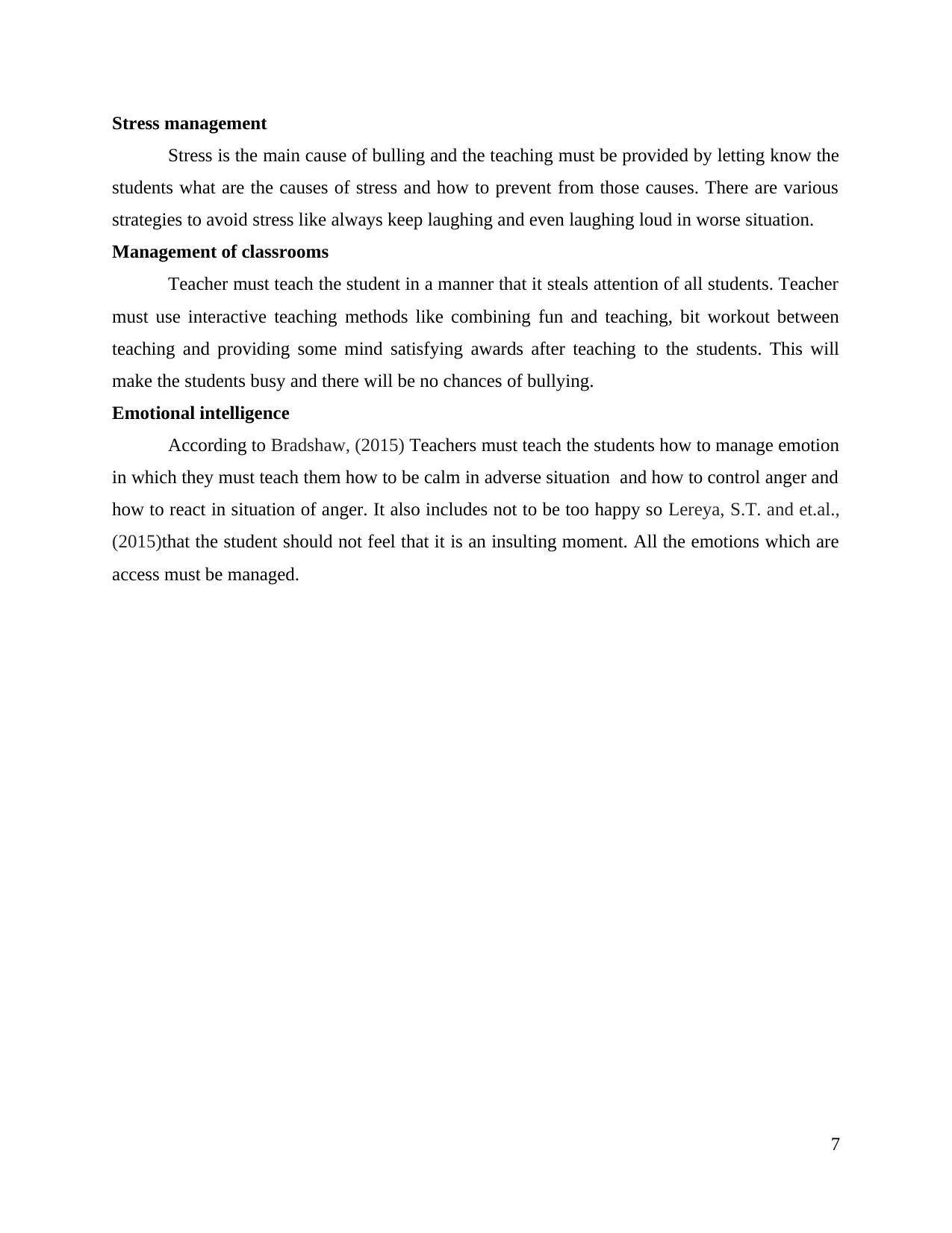
Stress management
Stress is the main cause of bulling and the teaching must be provided by letting know the
students what are the causes of stress and how to prevent from those causes. There are various
strategies to avoid stress like always keep laughing and even laughing loud in worse situation.
Management of classrooms
Teacher must teach the student in a manner that it steals attention of all students. Teacher
must use interactive teaching methods like combining fun and teaching, bit workout between
teaching and providing some mind satisfying awards after teaching to the students. This will
make the students busy and there will be no chances of bullying.
Emotional intelligence
According to Bradshaw, (2015) Teachers must teach the students how to manage emotion
in which they must teach them how to be calm in adverse situation and how to control anger and
how to react in situation of anger. It also includes not to be too happy so Lereya, S.T. and et.al.,
(2015)that the student should not feel that it is an insulting moment. All the emotions which are
access must be managed.
7
Stress is the main cause of bulling and the teaching must be provided by letting know the
students what are the causes of stress and how to prevent from those causes. There are various
strategies to avoid stress like always keep laughing and even laughing loud in worse situation.
Management of classrooms
Teacher must teach the student in a manner that it steals attention of all students. Teacher
must use interactive teaching methods like combining fun and teaching, bit workout between
teaching and providing some mind satisfying awards after teaching to the students. This will
make the students busy and there will be no chances of bullying.
Emotional intelligence
According to Bradshaw, (2015) Teachers must teach the students how to manage emotion
in which they must teach them how to be calm in adverse situation and how to control anger and
how to react in situation of anger. It also includes not to be too happy so Lereya, S.T. and et.al.,
(2015)that the student should not feel that it is an insulting moment. All the emotions which are
access must be managed.
7
Paraphrase This Document
Need a fresh take? Get an instant paraphrase of this document with our AI Paraphraser
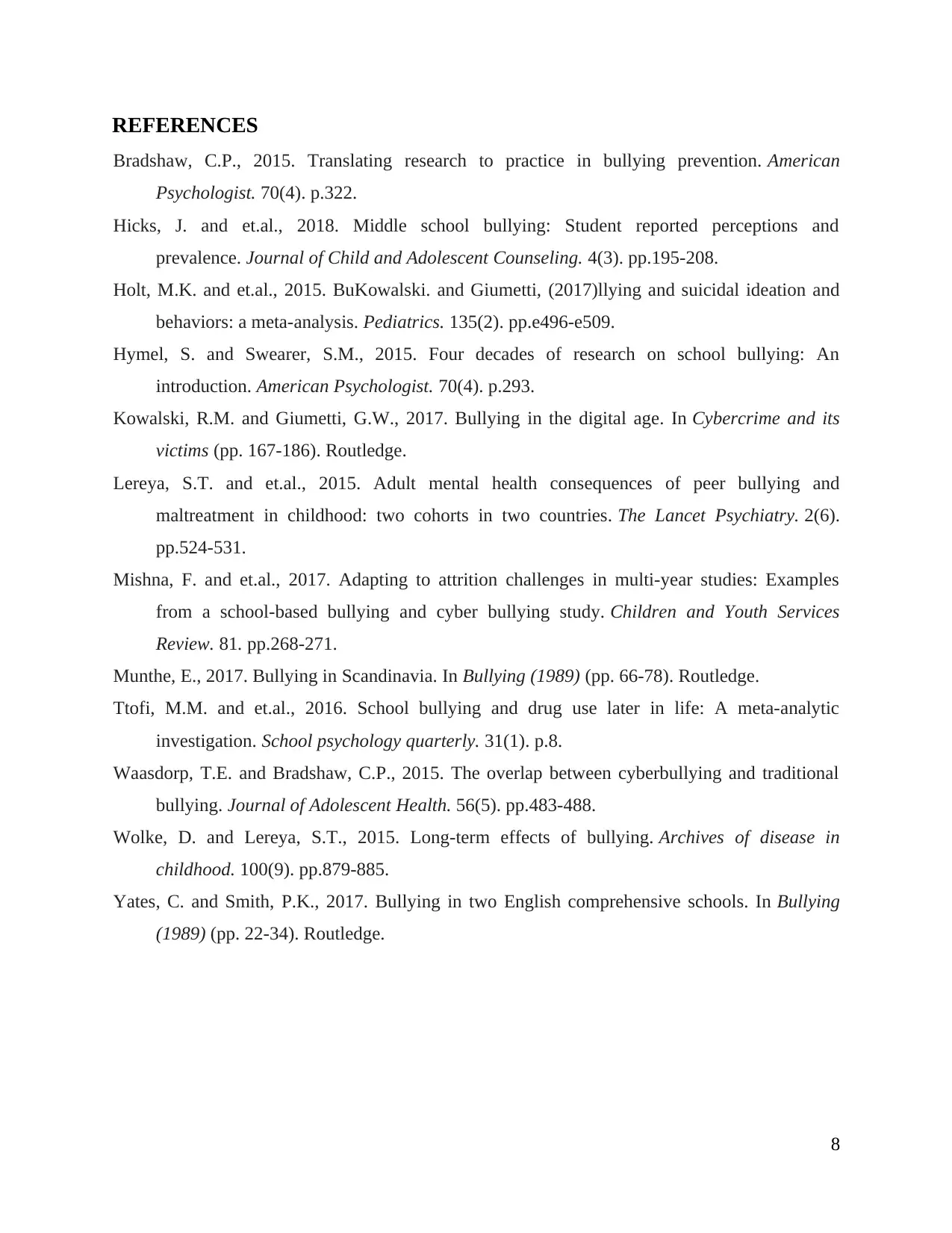
REFERENCES
Bradshaw, C.P., 2015. Translating research to practice in bullying prevention. American
Psychologist. 70(4). p.322.
Hicks, J. and et.al., 2018. Middle school bullying: Student reported perceptions and
prevalence. Journal of Child and Adolescent Counseling. 4(3). pp.195-208.
Holt, M.K. and et.al., 2015. BuKowalski. and Giumetti, (2017)llying and suicidal ideation and
behaviors: a meta-analysis. Pediatrics. 135(2). pp.e496-e509.
Hymel, S. and Swearer, S.M., 2015. Four decades of research on school bullying: An
introduction. American Psychologist. 70(4). p.293.
Kowalski, R.M. and Giumetti, G.W., 2017. Bullying in the digital age. In Cybercrime and its
victims (pp. 167-186). Routledge.
Lereya, S.T. and et.al., 2015. Adult mental health consequences of peer bullying and
maltreatment in childhood: two cohorts in two countries. The Lancet Psychiatry. 2(6).
pp.524-531.
Mishna, F. and et.al., 2017. Adapting to attrition challenges in multi-year studies: Examples
from a school-based bullying and cyber bullying study. Children and Youth Services
Review. 81. pp.268-271.
Munthe, E., 2017. Bullying in Scandinavia. In Bullying (1989) (pp. 66-78). Routledge.
Ttofi, M.M. and et.al., 2016. School bullying and drug use later in life: A meta-analytic
investigation. School psychology quarterly. 31(1). p.8.
Waasdorp, T.E. and Bradshaw, C.P., 2015. The overlap between cyberbullying and traditional
bullying. Journal of Adolescent Health. 56(5). pp.483-488.
Wolke, D. and Lereya, S.T., 2015. Long-term effects of bullying. Archives of disease in
childhood. 100(9). pp.879-885.
Yates, C. and Smith, P.K., 2017. Bullying in two English comprehensive schools. In Bullying
(1989) (pp. 22-34). Routledge.
8
Bradshaw, C.P., 2015. Translating research to practice in bullying prevention. American
Psychologist. 70(4). p.322.
Hicks, J. and et.al., 2018. Middle school bullying: Student reported perceptions and
prevalence. Journal of Child and Adolescent Counseling. 4(3). pp.195-208.
Holt, M.K. and et.al., 2015. BuKowalski. and Giumetti, (2017)llying and suicidal ideation and
behaviors: a meta-analysis. Pediatrics. 135(2). pp.e496-e509.
Hymel, S. and Swearer, S.M., 2015. Four decades of research on school bullying: An
introduction. American Psychologist. 70(4). p.293.
Kowalski, R.M. and Giumetti, G.W., 2017. Bullying in the digital age. In Cybercrime and its
victims (pp. 167-186). Routledge.
Lereya, S.T. and et.al., 2015. Adult mental health consequences of peer bullying and
maltreatment in childhood: two cohorts in two countries. The Lancet Psychiatry. 2(6).
pp.524-531.
Mishna, F. and et.al., 2017. Adapting to attrition challenges in multi-year studies: Examples
from a school-based bullying and cyber bullying study. Children and Youth Services
Review. 81. pp.268-271.
Munthe, E., 2017. Bullying in Scandinavia. In Bullying (1989) (pp. 66-78). Routledge.
Ttofi, M.M. and et.al., 2016. School bullying and drug use later in life: A meta-analytic
investigation. School psychology quarterly. 31(1). p.8.
Waasdorp, T.E. and Bradshaw, C.P., 2015. The overlap between cyberbullying and traditional
bullying. Journal of Adolescent Health. 56(5). pp.483-488.
Wolke, D. and Lereya, S.T., 2015. Long-term effects of bullying. Archives of disease in
childhood. 100(9). pp.879-885.
Yates, C. and Smith, P.K., 2017. Bullying in two English comprehensive schools. In Bullying
(1989) (pp. 22-34). Routledge.
8

9
⊘ This is a preview!⊘
Do you want full access?
Subscribe today to unlock all pages.

Trusted by 1+ million students worldwide
1 out of 12
Related Documents
Your All-in-One AI-Powered Toolkit for Academic Success.
+13062052269
info@desklib.com
Available 24*7 on WhatsApp / Email
![[object Object]](/_next/static/media/star-bottom.7253800d.svg)
Unlock your academic potential
Copyright © 2020–2025 A2Z Services. All Rights Reserved. Developed and managed by ZUCOL.





